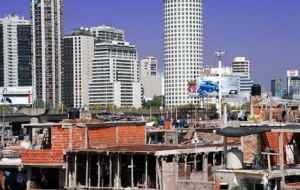MercoPress. South Atlantic News Agency
People living in Buenos Aires shanty towns increased 52% in ten years
 Some settlements have expanded their areas and most are growing upwards and are already in the fourth floor
Some settlements have expanded their areas and most are growing upwards and are already in the fourth floor The number of people living in shanty towns or “misery villages” in Argentina and particularly in the capital Buenos Aires keeps increasing despite a decade of sustained growth at almost Chinese rates. According to data from the latest census of 2010, the number of people living in 'misery villages' in Buenos Aires was 163.587 compared to the 107.422 in 2001, with a 52% increase.
It must be added that in the last decade no shanty town from Buenos Aires was removed, except for 'Cardboard city' which was first started by city authorities as an emergency settlement.
But the rest of shanty towns, long established have continued to advance both in the number of residents and area, and in the most consolidated there is a booming real estate market for lots and flats, mostly in downtown Buenos Aires, next to the main railways and walking distance from Casa Rosada, Government House.
According to Marina Klemensiewicz, head of the Habitat and Inclusion office from the Buenos Aires City government, in the last decade beginning in 2001 there has been a strong migratory wave to these 'informal cities', and not only in the Argentine capital, but in most of Latam large cities.
And those most consolidated, as Ms Klemensiewicz refers, “misery village 31” and “bis” have actually expanded their territory and existing constructions are already on the fourth floor, meaning at least 3.500 new families have moved in.
In effect although the area in 2001 was of 292.7 hectares and in 2010 it was down to 259.9 hectares, precarious housing has expanded along the railway lines leading to Buenos Aires city main stations.
“The important thing in the process of transforming a non formal city in a formal one is investing in infrastructure with participation of the local residents. That is why in each settlement we have a city government office so that they can appeal to the city when they need help. We must eliminate the middleman in the relation” explains Ms Klemensiewicz.
According to Buenos Aires city stats, almost 60% of the settlements' residents live to the south of the city, and in some neighborhoods they represent one in three inhabitants.
Insecurity is the main problem identified by residents in settlements. Half of them (or a member of their family) have been victims of some sort of crime at the settlement or in the surroundings, according to a research by Social Commitment Office from the Argentine Catholic University.
Another issue are violent conflicts perpetrated by gangs (80%) or groups from different sectors or different nationalities.




Top Comments
Disclaimer & comment rules-

-

-

Read all comments“a decade of sustained growth at almost Chinese rates”
Jan 09th, 2014 - 10:07 am 0Haha how almost?
I would have said hardly not almost
If the Argentine Government invested the money it wastes in trying to colonise the Falklands in housing and infrastructure development its citizens would be much better off.
Jan 09th, 2014 - 10:45 am 0A sq meter in the “missery village” like the ince*st brain of mercosh**t called it cost 1.000 US$.
Jan 09th, 2014 - 10:55 am 0A room with a single bed 300 US$.
I bet those guys in there have more money than some of the UK braindead of mercosh**t
Commenting for this story is now closed.
If you have a Facebook account, become a fan and comment on our Facebook Page!